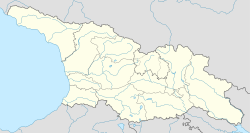Surami
|
Surami სურამი |
|
|---|---|
| Borough | |

Surami
|
|
| Location of Surami in Georgia | |
| Coordinates: 42°01′0″N 43°33′0″E / 42.01667°N 43.55000°E | |
| Country |
|
| Mkhare | Shida Kartli |
| Population (2014) | |
| • Total | 8,615 |
| Time zone | Georgian Time (UTC+4) |
Surami (Georgian: სურამი) is a small town (daba) in Georgia’s Shida Kartli region with the population of 8,615. It is a popular mountain climatic resort and a home to a medieval fortress.
Surami is located on the southern slopes of the Likhi Range (alternatively known as the Surami Range) which divides Georgia into its eastern and western parts, four km from the town Khashuri, to which Surami is connected through a railway spur.
The first human settlement on Surami's territory dates back to the early Bronze Age. It is probably the Surium of Classical authors, specifically Pliny the Elder (AD 23-79), who place it in the eastern part of Colchis, towards Iberia.
Strategically located at the entrance into the Borjomi Gorge and guarding the road from eastern to western Georgia, Surami became a heavily fortified town in the 12th century. From the 1170s to the latter part of the 14th century, the fortress of Surami was a hereditary fief of the dynasty of the eristavs ("dukes") of Kartli (central Georgia), who assumed the surname of Surameli (სურამელი; literally, "[lord] of Surami").
Subsequently, Surami declined but retained its lively trading post as well as the fortress which was reconstructed in the 16th and 17th centuries. By the mid-18th century, according to Prince Vakhushti, Surami had 200 households of Georgians, Armenians and Jews. In the 1740s, Surami was used by Prince Givi Amilakhvari as his base against King Teimuraz II and Persians. After the prince’s surrender in 1745, the fortress was demolished, but later restored and exploited by the Russo-Georgian troops in anti-Ottoman operations during the Russo-Turkish War (1768–1774). After the Russian annexation of Georgia in 1801, Surami housed a military post and was later popularized as a mountain climatic resort. In 1926, it acquired the status of "urban-type settlement" (Georgian: daba).
...
Wikipedia


